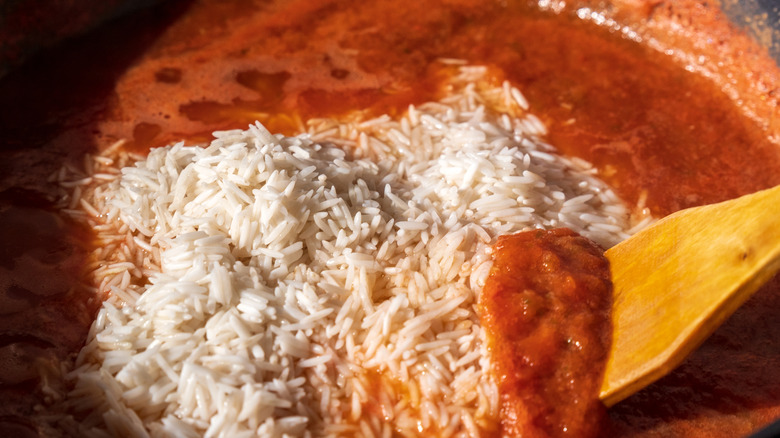Add Tomato Juice Before The Broth When Making Arroz Rojo
Arroz rojo is a staple of Mexican cuisine, and it owes its signature flavor and color to the power of the tomato. White and green rice, or arroz verde, are also prevalent in Mexican cooking, but if you order food at a Mexican restaurant, arroz rojo is likely what you'll be served. It's a favorite with good reason. Packed with flavor, it's usually paired with spicy pinto beans or entrees, but it's tasty enough to be eaten as a main course by itself.
Arroz rojo often includes spices like cumin or coriander and usually calls for onion as well, but the main taste comes from tomato. Tomato sauce brings a brightness and acidity to the rice that livens up all the other flavors in the dish, and of course, is essential to attain that beautiful red hue. The best arroz rojo is made with homemade tomato puree, but beyond that, there are a few tricks to improve your arroz rojo, and a big one is making sure to add your tomato juice before you mix in broth or water.
Adding your pureed tomato sauce before the other ingredients helps in two ways. First, it allows the rice to absorb some of the tomato liquid directly as it starts to hydrate, infusing it with more flavor. Second, when the tomato juice simmers in the hot pan before the other liquid is added it deepens the taste and imparts more of a cooked flavor to the whole dish.
Fresh tomato juice has a deeper flavor when it's cooked with the rice
Most recipes for arroz rojo call for fresh tomatoes to be pureed in a blender with garlic and onion to create a smooth sauce. While fresh tomatoes have a wonderful flavor, they can be a little watery and mild in their uncooked state. But heat is transformational for tomatoes, which is why you'll find recipes for slow-cooked tomato sauce from all over the world. But the long cook isn't always necessary: Cooking sauce, even for just a few minutes, concentrates the sweetness inherent in tomatoes, which greatly improves the taste and adds a depth of flavor to your arroz rojo. And initially frying fresh tomato puree in the direct high heat of the skillet, before the gentler cooking when the rice steams in the broth, emphasizes that effect.
You don't need to cook your tomato juice very long because with arroz rojo you are already frying your rice in a hot pan with oil to toast it. In just a few minutes the rice should absorb most of the tomato puree, and then you can add the stock. Just be careful to stir your rice and tomato mixture — in fact, letting it sit in the heat too long can scorch the sauce and impart a bitter flavor to the tomatoes. But hit just the right amount of heat and your arroz rojo will end up perfectly fluffy and deeply flavorful.

